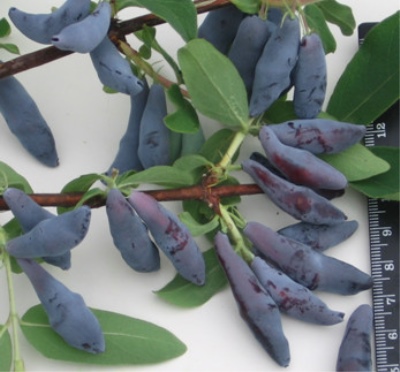
- Authors: Tkacheva A.T., Gidzyuk I.K., Savinkova N.V., Pavlovskaya A.P.
- Year of approval: 2006
- Growth type: medium-sized
- Description of the bush: sprawling
- Bush height, m: 1,6
- Escapes: thin, curved, light brown, hairless
- Leaves: medium, green, slightly pubescent
- Transportability: good
- Crown: spherical, medium density
- Fruit size: large
Often, honeysuckle can be found on a personal plot. This plant has special soil requirements and requires careful maintenance, such as the Pride Bakchar cultivar.
Description of the variety
This variety was allowed for use not so long ago, in 2006. The shrub is medium-sized with a spherical crown, which demonstrates a medium density. Usually it grows up to 1.6 m, in diameter it can be 1.2 m.
Fruit characteristics
The fruits of Pride Bakchar are universal. They demonstrate excellent transportability, but at the same time they have moderate crumbling.
The fruits are large, the weight can reach 1.3 grams. They are slightly curved in shape, the color is purple. There is a waxy coating on the skin, the skin is not very thick.
Taste qualities
The taste of Pride Bakchar is sweet with sourness, there is no bitterness.
Ripening and fruiting
This variety is medium late, begins to bear fruit in the third decade of July.
Yield
This indicator is at a high level. 2.6-3.2 kg are collected from the bush.

Growing regions
Can be grown in any region of Russia.
Self-fertility and the need for pollinators
Bakchar's pride requires pollinators, among them:
Bazhovskaya;
Delight;
Strezhevchanka.
Growing and care
Spring is considered the best time to plant this variety of honeysuckle, but you should not plant cuttings when the snow has not melted yet and some flowers have already bloomed. The optimal time is mid-spring. Planting honeysuckle in the fall is also possible and has its advantages, since in this case, in the spring, the plant can please with the first flowering.
The pride of Bakchar is planted in holes with a diameter several times larger than the root system. At the bottom, you should throw a shovel of garden compost or well-decomposed manure. We place the seedlings in the hole 5-10 cm deeper than they grew in the container. If we want to use supports, honeysuckle is planted at intervals of about 1 meter. And also young seedlings are best placed at a distance of at least 30-40 cm from walls or fences.
Shrubs like to keep the soil around the roots cool, so cover the area around with a layer of bark that will protect against heat and moisture loss.
This variety has good frost resistance and longevity (life expectancy 25-30 years).
Honeysuckle Pride Bakchar responds well to fertilization, both organic and mineral. The main thing is not to overdo it, as this can lead to undesirable consequences and even the death of the plant.
It is better to use organic matter in the form of humus and compost at the very beginning of spring or late autumn to saturate the soil with useful substances. Mineral additives work very quickly, stimulate the root system, increase growth, accelerate the formation of shoots and fruits. It is best to apply them in the second half of spring, when the buds appear. Nitrogen fertilizers, phosphate and potassium fertilizers are useful.
Fertilizers can be applied in liquid and dry form. Urea has proven itself well.
During flowering and emergence of berries on the Pride of Bakchar, special attention should be paid to watering.During a dry period, you can increase the amount of water for an adult bush to 3 or more buckets. After picking the berries, the plant no longer needs a lot of moisture, but nevertheless watering should be regular.
It is important! In early spring, it is recommended to water the bush with hot water to combat fungus and powdery mildew.
Weeding is carried out as needed, this procedure should be regular. In order not to damage the roots, it should be carried out to a depth of no more than 5 cm, which will lead to the saturation of the soil with oxygen and moisture. Preparing for winter, the ground under the bush can be carefully dug to a depth of no more than 10-15 cm.
Honeysuckle Care Bakchar's pride is also the right pruning. It is worth shortening the shoots by 1/3 of the length. This procedure will stimulate the plant to release more shoots, making the crown denser. Honeysuckle pruning is carried out for 2-3 seasons.
Do not forget about the presence of supports around which the honeysuckle Pride of Bakchar will be able to curl freely. You can use for this, poles, ladders or trellises.


Disease and pest resistance
The described variety has good disease and pest resistance.

Winter hardiness and the need for shelter
The pride of Bakchar is a winter-hardy variety, so there is no need for shelter.
Location and soil requirements
Honeysuckle of this variety grows best and blooms profusely in a sunny location. Loves soil from neutral to slightly alkaline, but clay, fertile and moist soils are best for her. It is not possible to grow the Pride of Bakchar in areas that are poor in humus, excessively wet or swampy.
It is not recommended to use dry areas with pits or bumps for planting the Pride of Bakchar.
When choosing a planting site, it is necessary to take into account the fact that the bushes can grow larger, so it is better to place them along the fence, or use them as a hedge.
The plant prefers to grow in bright sunny areas, sheltered from the wind. In the shadows, Bakchar's Pride will still bear fruit, but this may affect the quality and quantity of the harvest.
You should not plant a plant where groundwater is located close to the soil surface.
































































